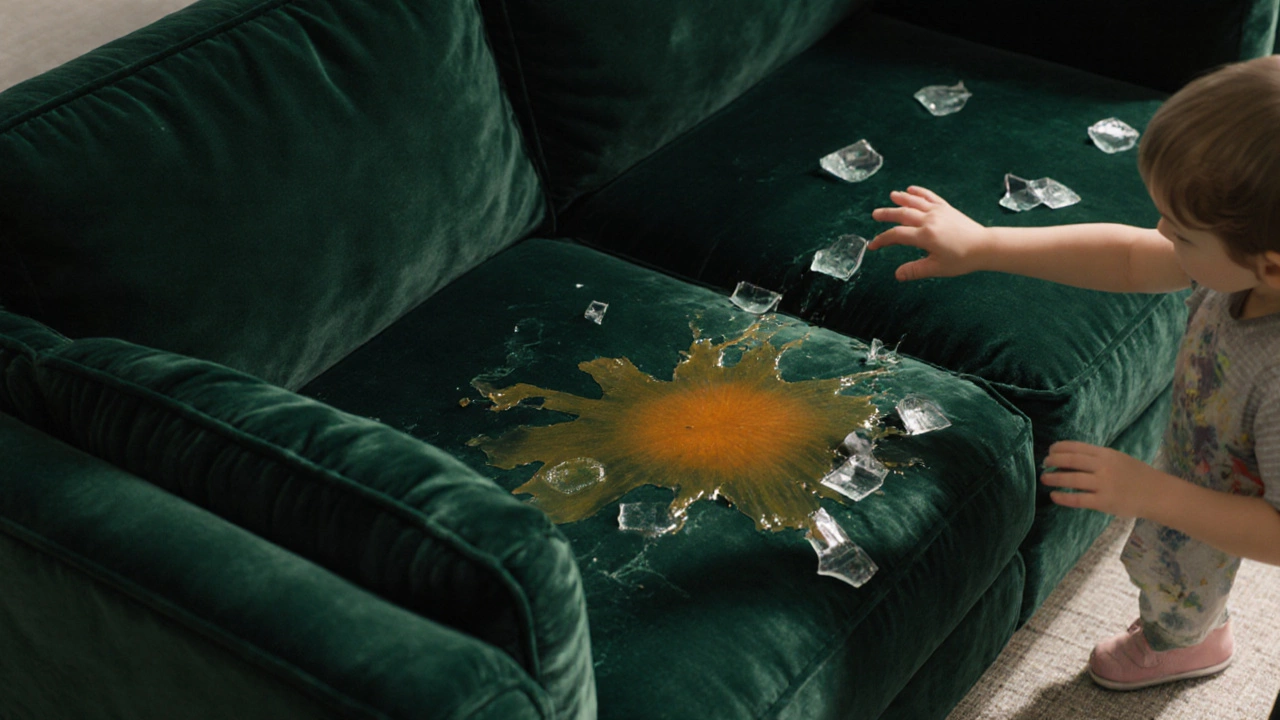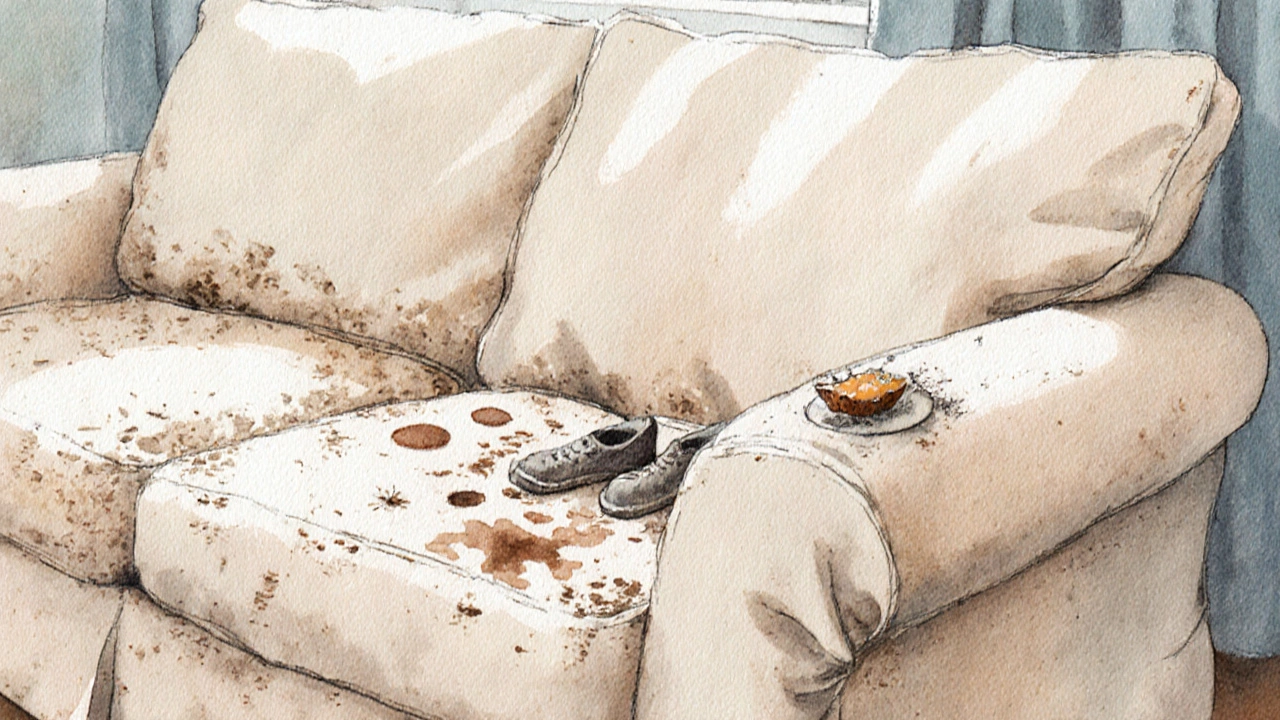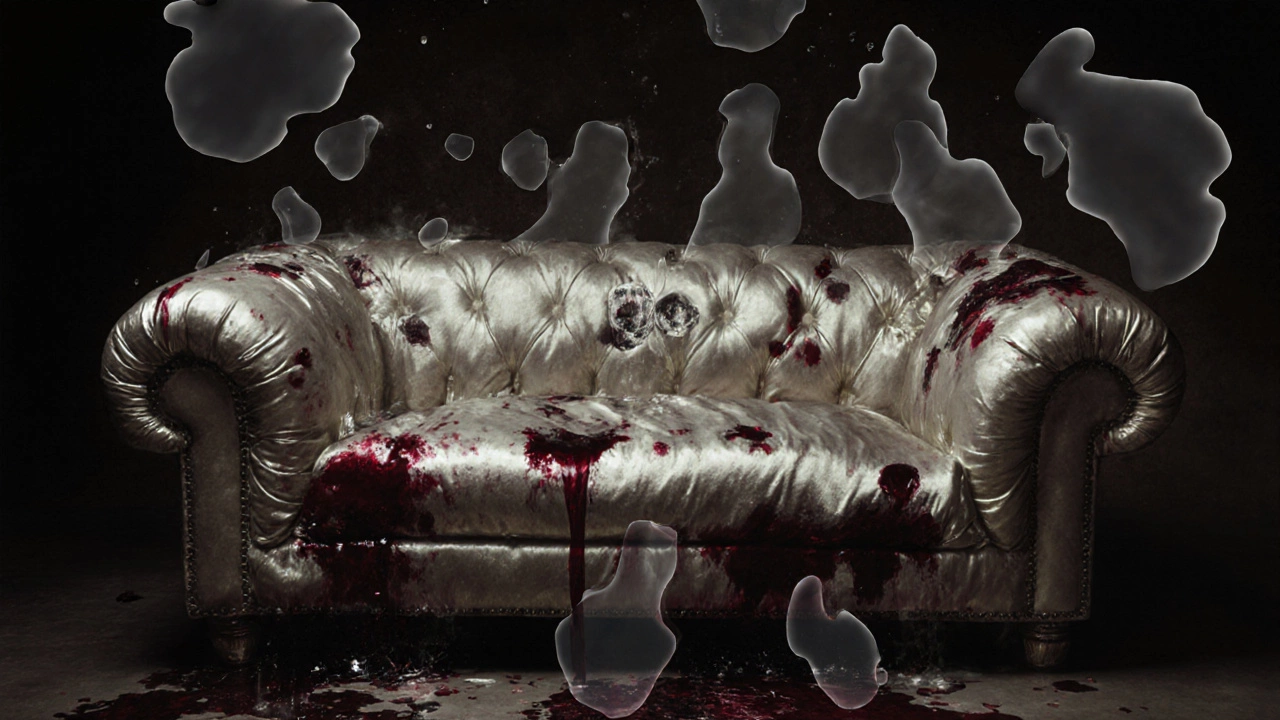What Is the Hardest Couch Material to Clean? Top 5 Difficult Fabrics and How to Handle Them

Couch Fabric Cleaning Difficulty Calculator
Select Your Fabric and Stain
Discover how difficult it will be to clean your couch based on fabric type and stain type.
Cleaning Difficulty
Recommended Cleaning Method
Estimated Cost
Everyone wants a couch that looks good and lasts long. But if you’ve ever spilled coffee on a white velvet sofa or tracked mud across a light-colored linen slipcover, you know not all fabrics are created equal when it comes to cleaning. Some materials look luxurious but turn into cleaning nightmares the moment something spills. So what’s the hardest couch material to clean? The answer isn’t just one fabric-it’s a group of textures that trap stains, attract lint, and refuse to bounce back after a mess.
Velvet: The Silent Stain Magnet
Velvet looks rich, soft, and expensive. It’s a favorite in modern living rooms and high-end rentals. But here’s the catch: velvet is a nightmare to clean. The dense pile holds onto dirt like a sponge. A spilled glass of red wine doesn’t just sit on top-it sinks into the fibers and spreads sideways under the surface. Even water can leave permanent watermarks because the nap gets crushed unevenly.
Most velvet couches aren’t machine washable. Professional cleaning is often the only option, and even then, the fabric may never look exactly the same. The pile can flatten in spots, leaving patches that look worn. Vacuuming with a brush attachment can help, but it won’t remove deep stains. And if you try scrubbing? You risk damaging the weave. In homes with kids, pets, or messy guests, velvet is a gamble you’re likely to lose.
Light-Colored Linen: A Dust and Stain Trap
Linen is breathable, natural, and has that relaxed, lived-in look. But if you’ve ever owned a white or cream linen sofa, you know it doesn’t stay that way for long. Linen fibers are absorbent and porous. Sweat from skin, oil from hair, food crumbs, pet dander-they all stick. And because it’s usually light in color, every speck of dirt shows up like a spotlight.
Unlike synthetic fabrics, linen doesn’t repel liquids. Spill juice? It soaks in fast. Track in dirt? It embeds into the weave. Spot cleaning often just spreads the stain. Machine washing linen slipcovers can shrink them or make them lose shape. Even dry cleaning can fade the color over time. Linen looks beautiful when it’s fresh-but it demands constant care. If you’re not willing to vacuum daily and treat stains immediately, avoid light linen.
Suede and Microsuede: The Texture Trap
Suede and microsuede are often grouped together because they look similar and behave the same way. Both have a napped surface that grabs onto everything: pet hair, dust, crumbs, ink, grease. The texture hides stains at first glance, which makes it worse-you don’t notice the mess until it’s too late.
Unlike leather, suede can’t be wiped clean. You need a special brush to lift the nap and a suede cleaner to tackle stains. Even then, greasy stains from snacks or lotion often leave permanent rings. And if you get water on it? It darkens the fabric in blotchy patches that don’t dry evenly. Microsuede is a bit more forgiving than real suede, but it still stains easily and can’t handle heavy soiling. In homes with dogs that shake off after walks or kids who eat snacks on the couch, suede is a slow-motion disaster.

Dark Silk and Satin: Delicate and Destructive
Silk and satin couches are rare, but they do exist-mostly in luxury interiors or as accent pieces. They shimmer, they feel smooth, and they’re incredibly fragile. One drop of water can leave a permanent mark. Oil from skin can yellow the fabric over time. Sunlight fades the color fast. And if you try to clean it with regular upholstery cleaner? You risk dissolving the fibers.
These materials require dry cleaning only. Even vacuuming too close can snag the weave. Dusting with a microfiber cloth might help, but it won’t remove deep stains. If you spill anything on silk or satin, you’re looking at a professional restoration job-often costing hundreds of dollars. Most people don’t realize how high-maintenance these fabrics are until they’ve already ruined their couch. For everyday use? Skip silk and satin entirely.
Organic Cotton with No Protective Coating
Organic cotton sounds eco-friendly and safe. And it is-until it gets dirty. Uncoated cotton is highly absorbent. It soaks up spills like a paper towel. Coffee, wine, pet accidents-they all penetrate deep. Unlike performance fabrics that have stain-resistant finishes, plain cotton has no defense.
Washing cotton slipcovers at home can lead to shrinking, fading, or pilling. Dry cleaning is expensive and can break down the fibers over time. And if the couch is a sectional or has fixed cushions? You can’t even remove the covers. That means you’re stuck with spot cleaning, which rarely works well on deep stains. Cotton might feel comfortable, but without a protective treatment, it’s one of the most frustrating materials to maintain.
What to Choose Instead
If you want a couch that survives real life, look for performance fabrics. Brands like Crypton, Sunbrella, and Revolution Fabrics are engineered to resist stains, moisture, and odors. These materials are tested for durability and clean easily with soap and water. Many are even safe for homes with pets and kids.
Another smart choice? Darker colors. A charcoal gray or navy sofa hides dust, crumbs, and minor spills better than white or beige. Leather, especially top-grain or full-grain, is easy to wipe down and lasts decades. Synthetic microfibers with a tight weave resist stains and don’t attract pet hair like velvet or suede.
Remember: beauty shouldn’t come at the cost of constant cleaning. A couch is a long-term investment. Choose a material that matches your lifestyle-not just your Instagram feed.

Quick Tips for Cleaning Problem Fabrics
- For velvet: Use a soft-bristle brush to lift the nap after vacuuming. Never scrub stains.
- For linen: Blot spills immediately with a dry towel. Use a mild detergent solution and rinse with a damp cloth.
- For suede: Use a suede eraser for surface marks. A vinegar-water spray (50/50) can help with light stains.
- For silk: Never use water. Call a professional textile cleaner immediately.
- For cotton: Pre-treat stains with baking soda and vinegar before attempting any wash.
Real-Life Example: What Happened to My Velvet Sofa
A friend in Wellington bought a deep emerald velvet sofa last year. It looked stunning. Three weeks later, her toddler knocked over a glass of juice. She tried blotting it. Then she used a damp cloth. Then she scrubbed. The stain spread. The nap flattened. The color faded in spots. She spent $800 on professional cleaning. The sofa looked better-but not like new. She ended up buying a second couch, this time in a dark performance fabric. She says it was the best $1,200 she ever spent.
Is microfiber easier to clean than velvet?
Yes, microfiber is much easier to clean than velvet. Microfiber has a tight, dense weave that repels liquids and doesn’t trap dirt as easily. Most stains can be wiped away with a damp cloth and mild soap. Velvet, on the other hand, absorbs spills, crushes under pressure, and requires professional cleaning to restore its appearance.
Can I use a steam cleaner on my couch?
It depends on the fabric. Steam can damage velvet, silk, and uncoated cotton by shrinking fibers or leaving water marks. It’s safe for most synthetic microfibers and leather if used on low heat and kept moving. Always check the manufacturer’s cleaning code (W, S, SW, or X) before using steam.
Why do some couches say "spot clean only"?
"Spot clean only" means the fabric can’t handle full immersion in water or machine washing. This is common with delicate materials like silk, wool blends, or uncoated cotton. The dyes can bleed, the fibers can shrink, or the structure can warp. Spot cleaning limits damage to the stained area, preserving the rest of the couch.
Are performance fabrics worth the extra cost?
Yes, if you have kids, pets, or entertain often. Performance fabrics like Crypton or Sunbrella are designed to resist stains, moisture, and odors. They cost more upfront but save money long-term by avoiding professional cleaning bills and early replacement. Many last 10+ years with minimal care.
Does leather ever stain?
Leather can stain, but it’s easier to clean than most fabrics. Wipe spills immediately with a damp cloth. Oil-based stains (like makeup or cooking grease) need a leather-specific cleaner. Avoid harsh chemicals. Over time, leather develops a patina, which is normal. It doesn’t look "dirty"-it looks lived-in.
Final Thought: Choose Your Couch Based on Your Life, Not Your Aesthetic
There’s no point in having the most beautiful couch if you’re constantly stressed about spills. The hardest materials to clean-velvet, linen, suede, silk, and plain cotton-are beautiful. But beauty without practicality is just a liability. If your life involves coffee, kids, dogs, or messy movie nights, pick a fabric that matches your reality. You’ll thank yourself in six months when your couch still looks good-and you didn’t have to call a cleaner.